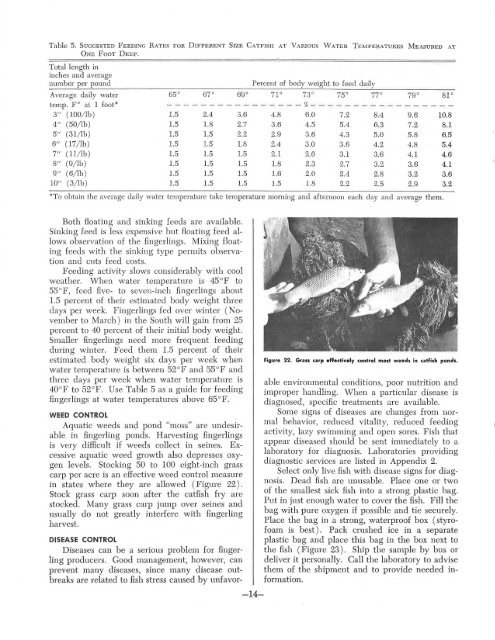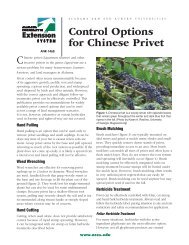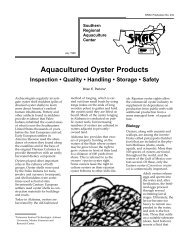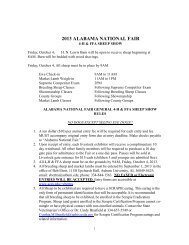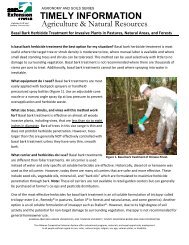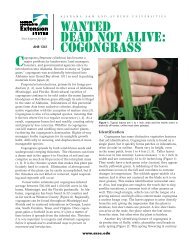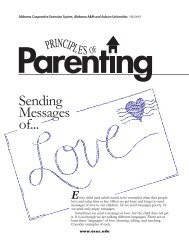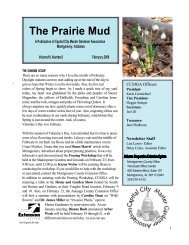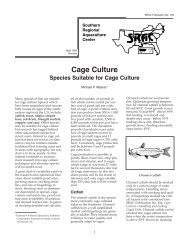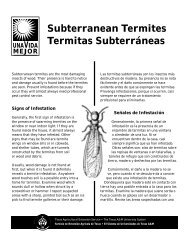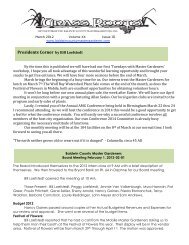PRODUCING - Alabama Cooperative Extension System
PRODUCING - Alabama Cooperative Extension System
PRODUCING - Alabama Cooperative Extension System
You also want an ePaper? Increase the reach of your titles
YUMPU automatically turns print PDFs into web optimized ePapers that Google loves.
Table 5. SuGGESTED FEEDING RATES FOR DIFFERENT SizE CATFISH AT VARIOUS WATER TEMPERATURES MEASURED AT<br />
ONE FooT DEEP.<br />
Total length in<br />
inches and average<br />
number per pound Percent of body weight to feed daily<br />
Average daily water 65° 67° 69° 7P 730 75° 770 79° 81°<br />
temp. F 0 at 1 foot" -------- - - - ----- %-----------------<br />
3" ( 100/lb) 1.5 2.4 3.6 4.8 6.0 7.2 8.4 9.6 10.8<br />
4" (50/lb) 1.5 1.8 2.7 3.6 4.5 5.4 6.3 7.2 8.1<br />
5" ( 31/lb) 1.5 1.5 2.2 2.9 3.6 4.3 5.0 5.8 6.5<br />
6" (17 /lb) 1.5 1.5 1.8 2.4 3.0 3.6 4.2 4.8 5.4<br />
7" ( 11/lb) 1.5 1.5 1.5 2.1 2.6 3.1 3.6 4.1 4.6<br />
8" (9/lb) 1.5 1.5 1.5 1.8 2.3 2.7 3.2 3.6 4.1<br />
9" (6/lb) 1.5 1.5 1.5 1.6 2.0 2.4 2.8 3.2 3.6<br />
10" (3/lb) 1.5 1.5 1.5 1.5 1.8 2.2 2.5 2.9 3.2<br />
"To obtain the average daily water temperature take temperature morning and afternoon each day and average them.<br />
Both floating and sinking feeds are available.<br />
Sinking feed is less expensive but floating feed allows<br />
observation of the fingerlings. Mixing floating<br />
feeds with the sinking type permits observation<br />
and cuts feed costs.<br />
Feeding activity slows considerably with cool<br />
weather. When water temperature is 45°F to<br />
55°F, feed five- to seven-inch fingerlings about<br />
1.5 percent of their estimated body weight three<br />
days per week. Fingerlings fed over winter (November<br />
to March) in the South will gain from 25<br />
percent to 40 percent of their initial body weight.<br />
Smaller fingerlings need more frequent feeding<br />
during winter. Feed them 1.5 percent of their<br />
estimated body weight six days per week when<br />
water temperature is between 52°F and 55°F and<br />
three days per week when water temperature is<br />
40°F to 52°F. Use Table 5 as a guide for feeding<br />
fingerlings at water temperatures above 65°F.<br />
WEED CONTROL<br />
Aquatic weeds and pond "moss" are undesirable<br />
in fingerling ponds. Harvesting fingerlings<br />
is very difficult if weeds collect in seines. Excessive<br />
aquatic weed growth also depresses oxygen<br />
levels. Stocking 50 to 100 eight-inch grass<br />
carp per acre is an effective weed control measure<br />
in states where they are allowed (Figure 22).<br />
Stock grass carp soon after the catfish fry are<br />
stocked. Many grass carp jump over seines and<br />
usually do not greatly interfere with fingerling<br />
harvest.<br />
DISEASE CONTROL<br />
Diseases can be a serious problem for fingerling<br />
producers. Good management, however, can<br />
prevent many diseases, since many disease outbreaks<br />
are related to fish stress caused by unfavor-<br />
-14-<br />
Figure 22. Grass carp effectively control most weeds in catfish ponds.<br />
able environmental conditions, poor nutrition and<br />
improper handling. When a particular disease is<br />
diagnosed, specific treatments are available.<br />
Some signs of diseases are changes from normal<br />
behavior, reduced vitality, reduced feeding<br />
activity, lazy swimming and open sores. Fish that<br />
appear diseased should be sent immediately to a<br />
laboratory for diagnosis. Laboratories providing<br />
diagnostic services are listed in Appendix 2.<br />
Select only live fish with disease signs for diagnosis.<br />
Dead fish are unusable. Place one or two<br />
of the smallest sick fish into a strong plastic bag.<br />
Put in just enough water to cover the fish. Fill the<br />
bag with pure oxygen if possible and tie securely.<br />
Place the bag in a strong, waterproof box ( styrofoam<br />
is best ) . Pack crushed ice in a separate<br />
plastic bag and place this bag in the box next to<br />
the fish (Figure 23). Ship the sample by bus or<br />
deliver it personally. Call the laboratory to advise<br />
them of the shipment and to provide needed information.


